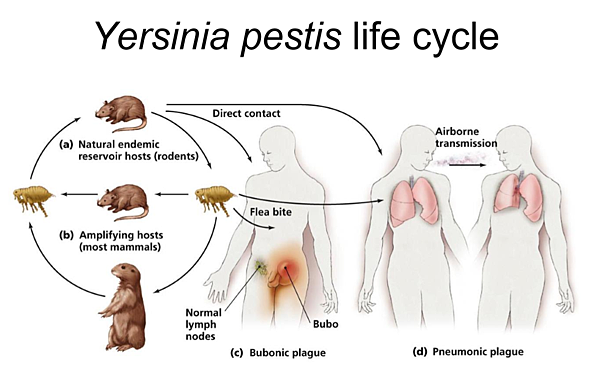Salmonella (沙門氏桿菌) (要和Shigella比較):侵犯血液淋巴(因為有鞭毛)
只有人有,在小腸
- attach to the mucosa of small intestine and invade into the M (microfold) cells
- type III secretion systems
invasion into the intestinal mucosa (Salmonella pathogenicity island 1 [SPI-1]) and subsequent systemic disease (SPI-2)
- intracellular replication in the phagosome
- Protected from stomach acids and the acid pH of the phagosome by an acid tolerance response (ATR) gene
- eating contaminated food
- Direct fecal-oral (adapted to human)
- Highly adapted to humans can survive in the gallbladder (膽囊)
- Replicate after being transported to the liver, spleen, and bone marrow
- Typhoid fever (傷寒) (在 developing country) (Typhoid Mary)
- Enteric fever (腸熱症)
S. typhi produce a febrile illness called typhoid fever (傷寒)
Shigella:少量即可致病,fecal-oral,沒有鞭毛(不侵犯血液淋巴)
只有人有,在大腸
- S. sonnei is the most common cause of shigellosis in the industrial world
- S. flexneri is the most common cause in developing countries
- invade the M cells
- survive phagocytosis by inducing programmed cell death (apoptosis)
S. dysenteriae (痢疾志賀氏桿菌) produce an exotoxin, Shiga toxin
Shiga toxin has one A subunit and five B subunits (Like the toxin produced by EHEC)
- damage to the intestinal epithelium and glomerular endothelial cells (resulting in HUS)
HUS(Hemolytic uremic syndrome)àShigella、EHEC 最嚴重
- Humans are only reservoir for Shigella
Yersinia.pestis:
- with a protein capsule, resist to phagocytic killing
- highly virulent pathogen that causes systemic disease with a high mortality rate
- zoonotic infection:flea bites (鼠蚤叮咬)
- inhalation of infectious aerosols (具感染性的口沫)
causes bubonic plague 腺鼠疫 (most common) and pulmonary plague肺鼠疫
Cold enrichment culture (寒冷增值法)
– Prolonged storage at 4°C can selectively enhance isolation
Klebsiella.pneumonia:
重要àcommunity-acquired,COPD
- Klebsiella.pneumonia primary liver abscess (KLA)
- K1、K2 capsular serotypes à biofilm
Proteus.mirabilis:
有很多ureaseà產生CO2,造成PH值上升à所以會有 renal stone ( kidney stone)
One minute exam
• 下列有關腸桿菌科菌種病原性決定因素的敘述,何者錯誤?
(A)有些腸桿菌會產生腸毒素,腸毒素為內毒素一種,可引起腹瀉
(B)內毒素的產生會引起病人發燒,甚至休克而死亡
(C)志賀氏菌、傷寒沙門氏桿菌均具有穿透腸道表皮層的能力
(D)腸內桿菌如克雷伯氏菌具有莢膜,能抵抗吞噬作用
Ans:(A)
• 大腸桿菌(Escherichia coli)所引起各種不同型態的腹瀉症( diarrhea)主要取決於:
(A)共同感染的其他細菌之種類
(B)此菌的體表抗原性
(C)宿主的免疫力
(D)此菌所產生的毒力因素
Ans:(D)
• 腸內桿菌科中比較容易感染呼吸道,造成鼻病及肺炎的細菌屬於下列何種細菌?
(A)克雷白氏桿菌屬(Klebsiella)
(B)志賀氏桿菌屬(Shigella)
(C)變形桿菌屬(Proteus)
(D)耶爾辛氏桿菌屬(Yersinia)
Ans:(A)
• 以下有關鼠疫之敘述,何者正確?
(A)肺鼠疫主要由鼠蚤之叮咬所引起
(B)腺鼠疫主要由吸入含鼠疫桿菌之飛沫所引起
(C)敗血性鼠疫乃因鼠疫桿菌由淋巴系統進入血流後所引起
(D)人類、鼠、蚤皆為鼠疫桿菌之自然宿主
Ans:(C)






 留言列表
留言列表


